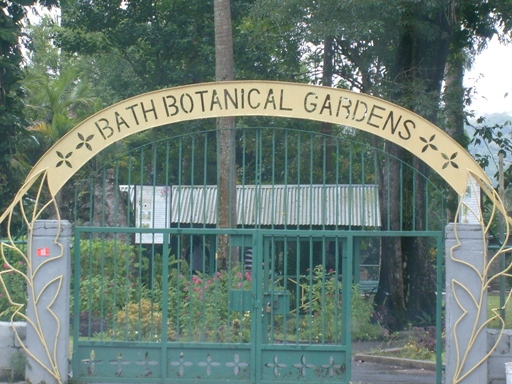
| Bath Hotel |
more to come |
The History of
Bath
Hotel Photo Gallery
Hotel Photo Gallery
Tradition widely held by local residents ascribes the
actual discovery of the springs to a runaway slave,
Jacob, who had been suffering from bed ulcers on his
legs. The story goes that while hiding from his master
in the wilderness of the Sulphur River gorge, Jacob
accidentally came across hot water gushing from a rock
and collecting in a pool below. Finding the water much
to his liking, he frequently returned to the pool to
soak his entire body in it. After doing this for some
time, he noticed that, much to his astonishment and
delight, his long-standing ulcers were healed, Having
been cured, the slave braved the wrath of his master,
Colonel Stanton, and returned to him and reported the
discovery of the magical healing properties of the
water.
In 1699, Colonel Stanton sold the spring and the
adjoining 1,130 acres of land to the Government got the
sum of four hundred pounds (₤400). By the early 1720's,
the springs were already in public use and were
attracting an increasing number of visitors from all
parts of the island who came to make use of the curative
properties of the water. People of wealth began
establishing residences in and around Bath of St. Thomas
the Apostle and the town of Bath sprang up at a site
about half mile south of the springs. The therapeutic
value and healing properties of these waters are well
known and have been referred to by a number of authors
in the past.
Since the establishment of the baths, thousands of
people suffering from gout, rheumatism, disorder of the
stomach, fever and various kinds of skin diseases have
derived tremendous benefits from the waters. Research
has shown that for maximum benefits, the water should be
ingested and the body infused (soaked) in the water for a
period of approximately 20 minutes.
Bath village is built on the banks of the Plantain
Garden River, the only stream in Jamaica which flows
from west to east. The village is located in the
interior of St. Thomas. Bath owes its origin in the
early 18th century to the discovery and development of
the spring. Hot water baths became very fashionable and
the village of Bath began to expand rapidly and soon
became a notable and exclusive retreat for ailing whites
that journeyed to Jamaica from the United Kingdom and
other European Countries. Many persons of fortune bought
lots and began to erect townhouses.
The square was soon adorned with a hospital, a public
lodging house and a billiard room. It became the fashion
every year for a crowd of company (socialites) to
assemble there from all quarters of the island and
abroad. At nights gaiety was in abundance, the powers of
music were ever-present and the card tables were not
idle. In short, from a destitute and desolate rural
area, Bath grew into a rendezvous for the polite and
social amusements for the most privileged. Bath also
became a Buccaneer weekend playground for the likes of
Captain Sir Henry Morgan and his gambling cohorts who,
in amorous indulgence, visited bath often whenever in
Jamaica. Many writers of this time claimed that within
the Jamaican plantocracy, Bath was a necessity where
both ladies and gentlemen of the wealthy and elite got
the opportunity to partake in the splendour as well as
the general over-indulgence in food and drinks.
Bath Botanical Garden

Bath Botanical Garden, the second oldest botanical garden in the Western Hemisphere, was established in 1779. Many of the plants introduced to Jamaica were first planted in this garden - among them are cinnamon, mango, jackfruit, croton, jacaranda and bougainvillea. The most important plant ever introduced in this garden was the breadfruit. The garden is much smaller today than when it was first established in 1779 and bears little trace of its former glory. There is, however, a fine stand of royal palms and a most splendid tree called the "Barrington Speciosa". There is also the screw pine with stilt roots, which were among the plants on board a French ship that was captured by the Flora in 1782, a ship in Lord Rodney's squadron at the battle of the Saintes, St. Lucia, the final Anglo-French battle in the Caribbean.
Bath Botanical Garden, the second oldest botanical garden in the Western Hemisphere, was established in 1779. Many of the plants introduced to Jamaica were first planted in this garden - among them are cinnamon, mango, jackfruit, croton, jacaranda and bougainvillea. The most important plant ever introduced in this garden was the breadfruit. The garden is much smaller today than when it was first established in 1779 and bears little trace of its former glory. There is, however, a fine stand of royal palms and a most splendid tree called the "Barrington Speciosa". There is also the screw pine with stilt roots, which were among the plants on board a French ship that was captured by the Flora in 1782, a ship in Lord Rodney's squadron at the battle of the Saintes, St. Lucia, the final Anglo-French battle in the Caribbean.
